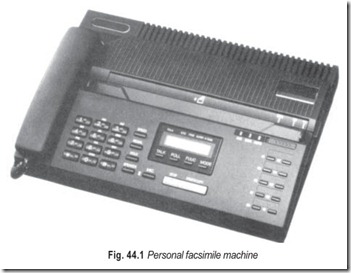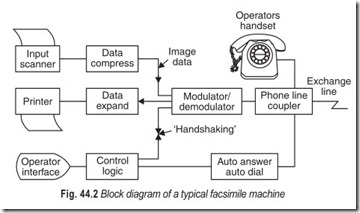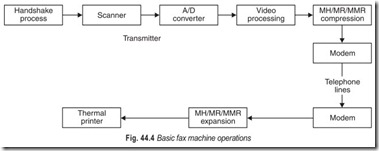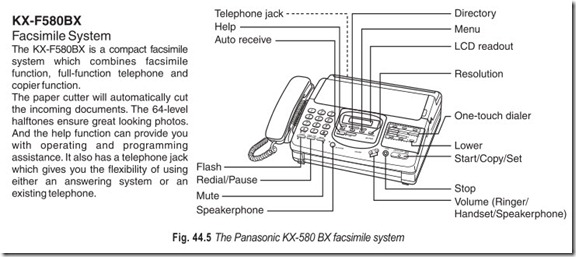FACSIMILE (FAX)
In addition to basic signals consisting of speech, music, or telegraph codes, a telecommunication system is often required to transmit signals of a visual nature. Facsimile means an exact reproduction, and in facsimile transmission an exact reproduction of a document or picture is provided at the receiving end. Television means visually at a distance and a television system is used to reproduce any scene at the receiving end.
It differs from facsimile in that the scene may be live (i.e. include movement).
Information is transmitted at a much faster rate in television transmission than it is in facsimile transmission. As a result, television transmission requires a much larger bandwidth, and special wideband circuits are required. The small bandwidth required for facsimile makes it suitable for transmission over normal telephone lines.
FACSIMILE MACHINE
An input scanner can be used to transmit images over a telecommunications link to a remote printer. This principle has been in use commercially for news photograph transmission since 1930s. Combined send/ receive machines suitable for office use became widely available in 1960s, and between 1980 and 1987 the number of machines connected to the world-wide telephone network grew from a quarter of a million to two million. Facsimile provides very fast transmission of almost any documentary material without specialist preparation. However, between 2 million and 10 million bits are required for a raster scan of an A4 page; this has to be compared with 20000 bits for a similar-sized page of ASCII-coded characters. This added transmission burden is somewhat alleviated by the ability to tolerate very high error rates.
The design of facsimile machines has been strongly influenced by the use of the PSTN (public switched telephone network). Firstly, the network was designed for speech, not data. Therefore the power/frequency/ time characteristics of the transmitted facsimile signal must be chosen to suit the network. Secondly, transmission time is expensive, so effective data compression and channel modulation methods must be used. Thirdly, since the public network is switched, every facsimile machine can in principle be connected to every other. Rigorous development and application of international standards is therefore necessary to ensure that this potential for interconnection is not wasted.
Fig. 44.2 shows the block diagram of a typical facsimile machine. When data is read from an input document it is first compressed and then modulated on to an audio-frequency carrier prior to being coupled to the line. The receive path is the reverse of this.
BASIC FAX MACHINE OPERATIONS
Essentially, a fax machine scans original documents, converts the scanned images into electrical signals, and transmits them over telephone lines to a receiving fax machine. The receiving fax machine in turn converts the received signals back into the graphical images of the original document and prints them. The basic Group 3 fax machine operations for transmitting a page are presented in Fig. 44.4.
The handshake process : The sending and receiving fax-modems set up the transmission protocols, transmission speed, and other settings between them in a handshake process. If one modem cannot transmit at the highest speed of the other, both modems agree to fallback to the next highest speed at which both modems can transmit on the line.
At the transmitting end :
1. Scanning : The images on the page are scanned and transformed into analog signals to begin the transmission process. Either a charge-coupled device or contact image sensor scanner scans the page being sent. A photosensor array of 1728 tiny sensors for A4 paper size (or 2048 for B4) targets very small picture elements (pixels) on a line of page, one sensor per pixel, resulting in 1728 (or 2048) bits per line. The array determines whether each pixel is black or white and accordingly generates a strong or weak electronic signal for that pixel.
A page is scanned line-by-line with all the pixels in a thin strip from 0.13 to 0.25 mm high across the top of the page, or between 10 and 12 scan lines per line of text. Successive strips are scanned until the whole page is converted into a series of electrical pulses. The amplitude of each pulse represents the brightness of the corresponding pixel. This scanning operation takes between five and ten seconds per page.
2. A/D Conversion : The scanner signals are converted from analog to digital with typically from one to six bits per pixel. After image processing is complete, one bit per pixel is produced.
3. Video Processing : The processing of the scanner data can be done on the analog scanner signal, the digital data, or both. It accomodates for the shading, distortions, and other aspects of the original image so that reproduction can be as accurate as possible.
4. Shading compensation checks for non uniformity in the scanner optical system and corrects distortions due to both, light sources as well as nonun iformity in the scanner element.
5. Thresholding : The conversion of the scanner output from grey level to a black-and-white level must also be performed. It may include dithering (or half-toning), a method of generating pseudo- grey scales.
Other video processing techniques include automatic background correction, automatic contrast control, edge enhancement and MTF (modulation transfer function) correction. These can be performed in one or two dimensions. Images may also be reduced or enlarged.
6. Compressing the digital signals : The data compression operation can reduce the picture information by a factor of from 5 to 20, depending on the characteristics of the image. This operation generates code words containing the pixel imformation in compressed digital signals.
7. Modulation : The compressed digital signals are modulated by the modem into analog signals (a tone series) that can be sent over regular telephone lines. Group 3 fax machines are half duplex and can either send or receive at any time.
8. Transmission: The analog signals are then transmitted over the phone lines from the sending modem to the receiving modem.
At the receiving end :
1. Demodulation : A modem demodulates or decodes the received analog tone signals regenerating
the digital signals (bit streams) sent.
2. Decompression : The next step is to expand the digital signals and reconstruct the page’s images into black-and-white pixels which represent the pixel’s of the page’s image.
3. Thermal printing: The thermal printer converts the expanded bit stream into a copy of the original page. The printer’s wires are spaced 203 to the inch, touching the temperature-sensitive recording paper. For black marking, the wires heat up when high current passes through them. The wires go from non-marking (white) to marking (black) temperature, and back again in a few milliseconds.
4. Resolution : Standard resolution is 203 lines per inch across and 98 lines per inch down the page.
Fine resolution requires twice the number of lines (196 lines per inch) down the page. Most group 3 fax machines include a high resolution option.
GROUP 3 FAX MACHINES
Group 3 fax machines now comprise the overwhelming majority of fax machines in operation worldwide.
Group 3 refers to the digital standard that ensures compatibility among fax machines.
The Group 1 (1968) analog standard covered four and six minutes per page fax machines, while the Group 2 (1976) analog standard covered two and three minutes per page machines. The Group 3 digital standard was first adopted in 1980. It calls for the ability to send an 8.5 × 11 inch page in approximately 30 seconds over a voice grade telephone line. Group 3 fax machines actually do better. They can send an average page of text in 10 to 30 seconds with about 15 seconds for the initial first page handshake. The time per page really depends on how many black markings (text and graphics images) are present, on their level of detail and on the compression scheme used.
Due to advancing technology the Group 3 standard has been revised several times since 1980. Most notable advances in VLSI chip technology and DSP have resulted in increased data rates that significantly reduce transmission time.
Group 4 fax machines, which transmit at 64,000 bps, will be suited to computer controlled network communications. First adopted in 1984, Group 4 fax machines are designed for transmission over ISDN.
While Group 3 machines excel at stand-alone, person-to-person communications, Group 4 fax machines will be suited to computer-controlled network communications. However the installed base of Group 4 machines today is very small compared to Group 3 machines and they are comparatively expensive.
EXERCISES
Descriptive Questions
1. Draw the block diagram of, and briefly explain, a facsimile machine.
2. Explain basic fax machine operations.
3. Write short notes on :
(a) The handshake process (b) Decompression
(c) Resolution (d) Group 3 fax machines
Fill in the Blanks
1. Fax means ……………………. reproduction.
2. Fax can be transmitted over normal……………………. .
3. Fax provides……………………. transmission of almost any documentary material.
4. If one modem cannot transmit at the highest speed of the other, both modems agree to ……………………. to the next highest speed at which both modems can transmit on the line.
5. Shading compensation checks for……………………. in the scanner optical system.
6. Data compression reduces the picture information by a factor of from……………………. .
7. Group 3 fax machines are……………………. and can either send or receive at any time.
8. Fine resolution requires……………………. the number of lines down the page.
9. Group 3 fax machines include a……………………. option.
ANSWERS
Fill in the Blanks
|
1. exact |
2. telephone lines |
3. very fast |
|
4. fall back 7. half duplex |
5. nonuniformities 8. twice |
6. 5 to 20 9. high resolution |




